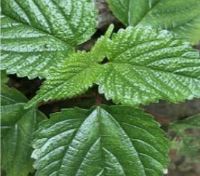<i>In vitro</i> Evaluation Of The Hypoglycaemic, Anti-Inflammatory, And Antioxidant Activities Of <i>Tragia benthamii</i> Baker (EUPHORBIACEAE)
Main Article Content
Abstract
Tragia benthamii Baker (Euphorbiaceae) is a climbing herb with significant traditional uses in Africa, particularly in Western Africa. This study aimed to evaluate the invitro hypoglycemic, anti-inflammatory, and antioxidant effects of Tragia benthamii leaves. The alpha-amylase inhibition and membrane stabilization assays were employed to evaluate the invitro hypoglycemic and anti-inflammatory activities of the methanol extract, n-hexane, chloroform, and ethylacetate fractions. Additionally, the antioxidant activity of the methanol crude extract was investigated using the DPPH (1,1-diphenyl-2-picrylhydrazyl) radical scavenging and ferric-reducing antioxidant power (FRAP) assays. The IC50 values obtained for the alpha-amylase inhibition were 63.52±0.069, 193.9±0.077, 913.19±0.044, and 3559.89±0.057 µg/mL for the methanol extract, n-hexane, chloroform, and ethylacetate fractions, respectively, while the reference drug sample, acarbose, exhibited an IC50 value of 455.30±0.063 µg/mL. IC50 values for the anti-inflammatory activity were 82.75±0.005, 75.06±0.02, 64.92±0.014, and 105.74±0.056 µg/mL for the methanol extract, n-hexane, chloroform, and ethylacetate fractions, respectively, and the reference drug, diclofenac, had an IC50 value of 53.26±0.002 µg/mL. Moreover, the IC50 values for the DPPH assay were 46.07±0.043, 53.78±0.008, and 7.43±0.008 µg/ml for the crude methanol extract, vitamin E, and vitamin C, respectively. The FRAP assay demonstrated that the leaf extract exhibited a total antioxidant activity of 185 µM Fe2+/g dry extract, whereas vitamin C (positive control) showed an activity of 405 µM Fe2+/g. Overall, this study indicates the potential hypoglycemic, anti-inflammatory, and antioxidant properties of T. benthamii leaf extracts.
Metrics
Article Details

This work is licensed under a Creative Commons Attribution-NonCommercial 4.0 International License.
References
Shamsudin NF, Ahmed QU, Mahmood S, Ali Shah SA, Khatib A, Mukhtar S, Alsharif MA, Parveen H, Zakaria ZA. Antibacterial Effects of Flavonoids and Their Structure-Activity Relationship Study: A Comparative Interpretation. Mol. 2022; 27(4):1149. https://doi.org/10.3390/molecules27041149.
Ezeunala MN, Izebe K, Aboh M, Ijele I, Ibekwe N, Ezaka E, Oladosu P, Adigwe PO. The use of common and exotic teas in managing covid-19 related symptoms. J Phytomed. Ther. 2022; 21(2): 871-882.
Muscolo A, Mariateresa O, Giulio T, Mariateresa R. Oxidative Stress: The Role of Antioxidant Phytochemicals in the Prevention and Treatment of Diseases. Int J Mol Sci. 2024 Mar 13;25(6):3264. doi: 10.3390/ijms25063264.
Schmelzer GH, Gurib-Fakim A. Plant Resource of Tropical Africa 11 (1) Medicinal Plants. PROTA Foundation, Wageningen, Netherlands/ Backhuys Publishers, Leiden, Netherlands/CTA, Wageningen, Netherlands. 2008; 791.
Narasimhan S. Pharmacological Potential of the Stinging Plant Tragia Species: A Review. Pharmacog J. 2021;13(1): 278-84.
Oladosu IA, Balogun SO, Ademowo GO. Phytochemical screening, antimalarial and histopathological studies of Allophylus africanus and Tragia benthamii, Chin. J. Nat. Med. 2013;11(4):371-376. DOI: 10.1016/S1875-5364(13)60054-0
Olaoye SB, Ibrahim AO, Zhingang. Chemical composition and radical scanvenging potentials of essentials oils from Tragia benthamii and Cissus aralioides, J. Biol. Act. Prod Nat. 2016; 6: (1), 59-64.
Frimpong EK, Asong JA, Aremu AO. A Review on Medicinal Plants Used in the Management of Headache in Africa. Plants (Basel). 2021;10(10):2038. doi: 10.3390/plants10102038.
Dhara AK, Pal S, Chaudhuri AK. Psychopharmacological studies on Tragia involucrata root extract, Phytother Res. 2002;16:326-330. DOI: 10.1002/ptr.891
Palani S. Kumar SN, Gokulan R, Rajalingam D. Evaluation of nephroprotective and antioxidant potential of Tragia involucrate, Drug Invent Today. 2009;1(1):55-60. DOI: 10.1002/ptr.891
Velu V, Das M, Raj A, Dua K, Malipeddi H. Evaluation of in-vitro and in-vivo anti-urolithiatic activity of silver nanoparticles containing aqueous leaf extract of Tragia involucrate. Drug Deliv. Trans. Res. 2017;27(3):439-449. DOI:10.1007/s13346-017-0363-x
Velu V, Malipeddi H, Saraswathi S, Das P. In-vitro antidiabetic activity of Tragia involucrata linn. leaf extracts, Int. J. Res in Ayurveda Pharm. 2015;6:1-3. DOI:10.7897/2277-4343.0611
Chatterjee A, Sukul NC. Nematicidal action of three wild plants. Nematologica. 1980; 26:500-502.
Reddy BS, Rao NR, Vijeepallam K, Pandy V. Phytochemical, pharmacological and biological profiles of Tragia species (Euphorbiaceae). Afr J. Tradit Complement, Altern Med. 2017;14(3):105-112. DOI: 10.21010/ajtcam. v14i3.11
Ijoma I, Ajiwe V. Phytochemical Screening of Dialium Indum Leaf extract (Velvet Tarmarind). Int. J. Phytopharmacy. 2017; 6-13. 10.7439/ijpp.v7i1.3942.
Heidari R, Zareae S, Heidarizadeh M. Extraction, Purification, and Inhibitory Effect of alpha - amylase inhibitor from Wheat (Triticum aestivum Var. Zarrin), Pak J. Nutr. 2005;4(10): 101-105. DOI:10.3923/pjn.2005.101.105
Gandhidasan R, Thamaraichelvan A and Baburay S. Anti-inflammatory action of Lannae coromandelica by HRBC membrane stabilization, Fitoterapia.1991; 52;(1):81-83.
Shenoy S, Shwetha K, Prabhu K, Maradi R, Bairy KL, Shanbhag T. Evaluation of anti-inflammatory activity of Tephrosia purpurea in rats. Asian Pac. J. Trop. Med. 2010;3(3):193-195. doi.org/10.1016/S1995-7645(10)60007-7
Ayoola GA, Adeyemi DK, Johnson OO and Eze OS. Phytochemical screening, antioxidant, antiulcer and toxicity studies of the leaves and stems of Desmodium adscendens. Trop J. Pharm. Res. 2018; 17 (7): 1301-1307
Jayameena P, Sivakumari K, Ashok K, Rajesh S. In-vitro anti-inflammatory (membrane stabilization) and antioxidant potential of Rutin. Res. J. of Life Sci. Bioinform Pharm. Chem. Sci. 2018;4(3):265-274. DOI:10.26479/2018.0403.24
Ayoola GA, Adeyemi DK, Johnson OO, Lawal LO. Evaluation of the phytochemical content, antioxidant and antimicrobial activity of Citrullus lanatus (Thunb) Seed methanol extract. Niger. J. Sci. Res. 2017;16(2):211-216.
Ponnusamy S, Ravindran R, Zinjarde S, Bhargava S, Kumar AR. Evaluation of traditional Indian antidiabetic medicinal plants for human pancreatic amylase inhibitory effect in-vitro. Evid-based compl. Alt. med. 2011; Article ID 515647. doi.org/10.1155/2011/515647
Hendra R, Army MK, Frimayanti N, Teruna HY, Abdulah R, Nugraha AS. α-glucosidase and α-amylase inhibitory activity of flavonols from Stenochlaena palustris
(Burm.f.) Bedd. Saudi Pharm. J. 2024;32(2): 101940. doi.org/10.1016/j.jsps.2023.101940.
Tran N, Pham B, Le L. Bioactive Compounds in Anti-Diabetic Plants: From Herbal Medicine to Modern Drug Discovery. Biology (Basel). 2020; 9(9):252. doi: 10.3390/biology9090252.
Devi NK, Periyanayagam K. In-vitro anti-inflammatory activity of Plectranthus amboinicus (lour) Spreng by HRBC membrane stabilization. Int. J. Pharm. Studies Res. 2010;1(1): 26-29.
Vadivu R, Lakshmi KS. In vitro and in vivo anti-inflammatory activity of leaves of Symploco scochinchnensis (Lour) Moore ssplaurina. Bangladesh J. Pharmacol. 2008; 3:121-124. DOI:10.3329/bjp. v3i2.956
Raju VH, Ganapaty S, Prasanna Shankararao S, Vijaya GJ, Kishori PS, Asif AK. Phytochemical and pharmacological evaluation of Tragia cannabina for anti-inflammatory activity. Int. Cur. Pharm. J. 2012; 1:213–216. doi.org/10.3329/icpj. v1i8.11253


